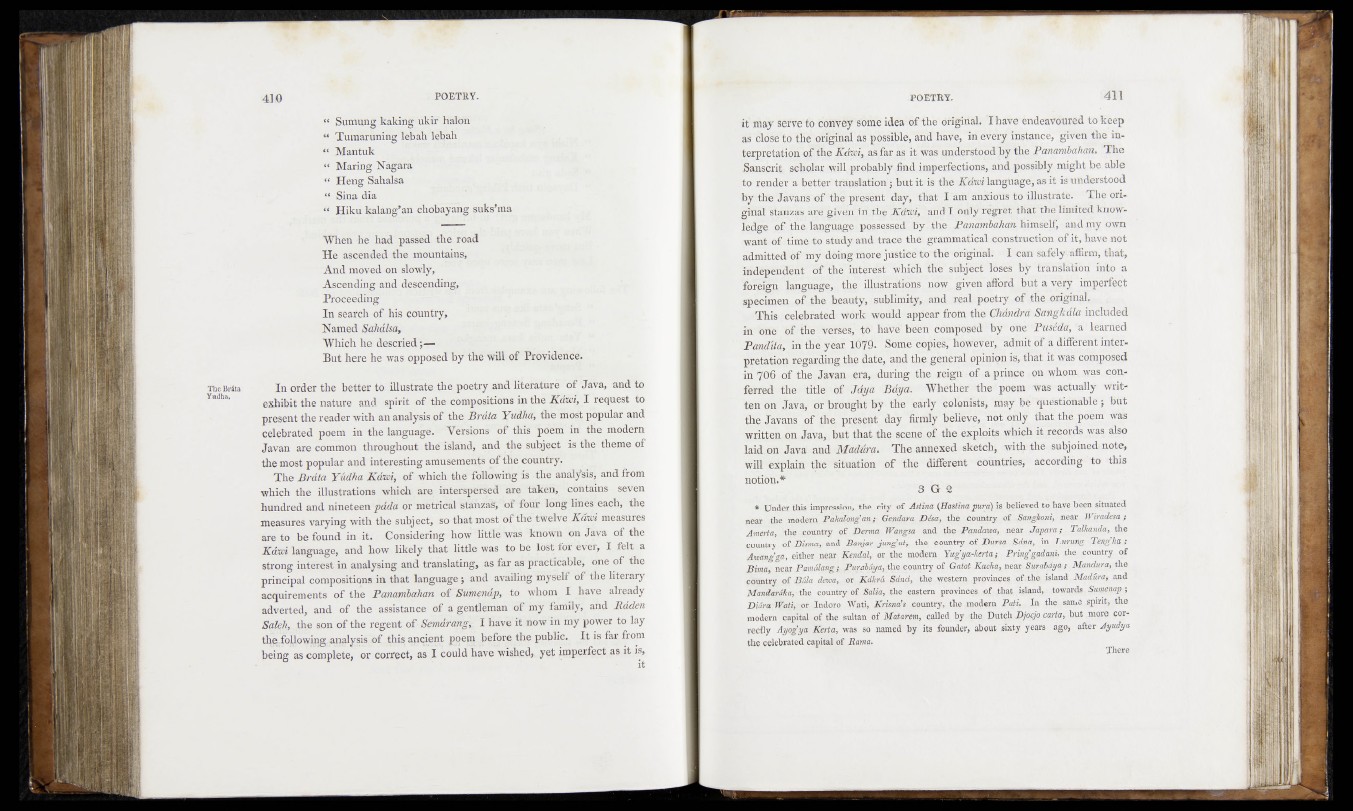
“ Sumung kaking ukif halen
M Tumaruning lebah lebah
“ Mantuk
P Mating Nagara
“ Heng Sahalsa
“ Sina dia
“ TTikn kalang’an chobayang suks’ma
When he had passed the road
He ascended the mountains,
And moved on slowly,
Ascending and descending,
Proceeding
In search of his country,
Named Sahdlsa,
Which he descried;—
But here he was opposed by the will of Providence.
In order the better to illustrate the poetry and literature; óf "Java, and to
exhibit the nature and spirit of the compositions in the Kdwi, I^reque&j; to
present the reader with an analysis of the Brdta Yudha', the most popular and
celebrated poem in the language. Versions of this poem fir the modern
Javan are common throughout thé island, and the subject is the theme 'of
the most popular and interesting amusements of the country.
The Brdta Yddha Kdwi, of which the following is the analysis, and from
which the illustrations which are interspersed' are taken, contains seven
hundred and nineteen 'pdda or metrical stanzas',' of four long lines’ each, the
measures varying with the subject, so that most óf'th’é” twelve Kami measures
are to be found in it. Considering how little was known on Java of the
K óm language, and how likely that little was to be lost for ever, I felt a
strong interest in analysing and translating, as far as practicable, one of the
principal compositions in that language $ and availing 'iriySfelf o f the literary
acquirements of the Panambahan off Sumendp, to whom I ^have already
adverted, and of the assistance of a gentleman of my family, and Béden
Saleh, the son of the regent of- Semdrang-,- I have it now in my power to lay
th'ft fo.l1nyyipg analysis o f this, ancient pgepa .fiefore the public, f t is far from
being as complete, or correct, as I could have wished,, yet imperfect as it is,
• it
it may serve to Cöhvèy s'Oihe idea of fhe original. ’Ihaye endeavoured to keep
as close to the original as possible, and have, in every instance, given the interpretation
of the Kdwi, asfar as it was understood fjy the Panambahan. The
Sanscrit scholar will, probably jfind imperfections, and possibly might be able
to render a better translation; but it'ïs' thê Kdwi language, as it is understood
by the Javans’Of’’the" present day, that I am anxious to illustrate. The original
stanzas are givifn'ln jtije Kdwi, and T "Only regret th a t the limited knowledge
l>f,the language bp o s ^ s s ^ by - the Panambahan himself, - and my own
want of time to study, and trace the. grammatical construction of it, have not
admitted'Of ray' dOing mOre justice tb'the original. I can safely,-affirm, that,
independent’ óf the interest which the subject 'lóses by- translation into a
foreign language, the" illustrations now. given afford but a very imperfect
specimen.,of the beauty, sublimity, and . real poetry ,of lhe-,9,riginalr;-.L.
This celebrated work- would appear from' the GMndrd Sangkdla included
in onê- óf tHe1 v'èfiïes? töf havë‘ béen cömpóséd’1' byi'dnér'PvAéda, ;a ‘ lë&riied
Pandifa, in the year 1079.' Sohië cpplës,’howeyer,. a d f i d t o f different-interpretation
regarding the date, and th e general ppiniop is, that it was composed
in .%O6,;0f the .Javan era, during the reign., of a prince „on whom, was conferred
the title of Ja y a B a y a. 'Whether th e ’poem -was actually writ*
ten oh Java, or brought by the early ^cdlbmstsj may be- questionable ; but
the Javans of jtHe, present day firmly believé, nót only that thejaoSh was
written on Java, but tha,t the scene of th e exploits which it .records was also
laid.on Java and Madéra. The annexed sketch, with the subjoined/note,
will explain the "situation of the different countries, according to this
notion.*
• ; s g 2
• Under this imprps*mn_,"jtiie. city of Astina (Basiina puraj. is bèEeyed to have been situate^
near die modern Pakalang’an; Gendom Désa, the country of pangkoni, - near JYiradesa ;
Amerta the .country of Derma Wangsa and jthe• Pmdaïoa, near Japara; Talkcnzda, the
country of Risma and Banjar jung'ut, the country _ofZ)«rsa Sdna, in Lurung •Jeng’k a ;
Awang'ga, father near Kendal, or the modern Yug’yarherta; Pring’gadtfqi, .the poultry of
£ima, near Pam&langPurql6ya,Jhe country of Gatot Kacha, near Skraidya ; Mandura, tlie
country of Bala dema, or Kdlcru, Sdnd, the western provinces of the island Madura, and
Mandaruka, the country of Scdia, the eastern provinces of that island,,- towards Suffleqap;
Didra Wati, or Jndoro Wati, Krisna’s -country, the ,mpdern P,ati. ( In the same -Spidtj (the
modern capital of the sultan of Matarem, called by the Dutch Jdjocjo carta, bpt .more correctly
Ayog’ya Kerta, was so named by its founder, about sixty years ago, after Ayudya
the celebrated, capital of Rama.
There